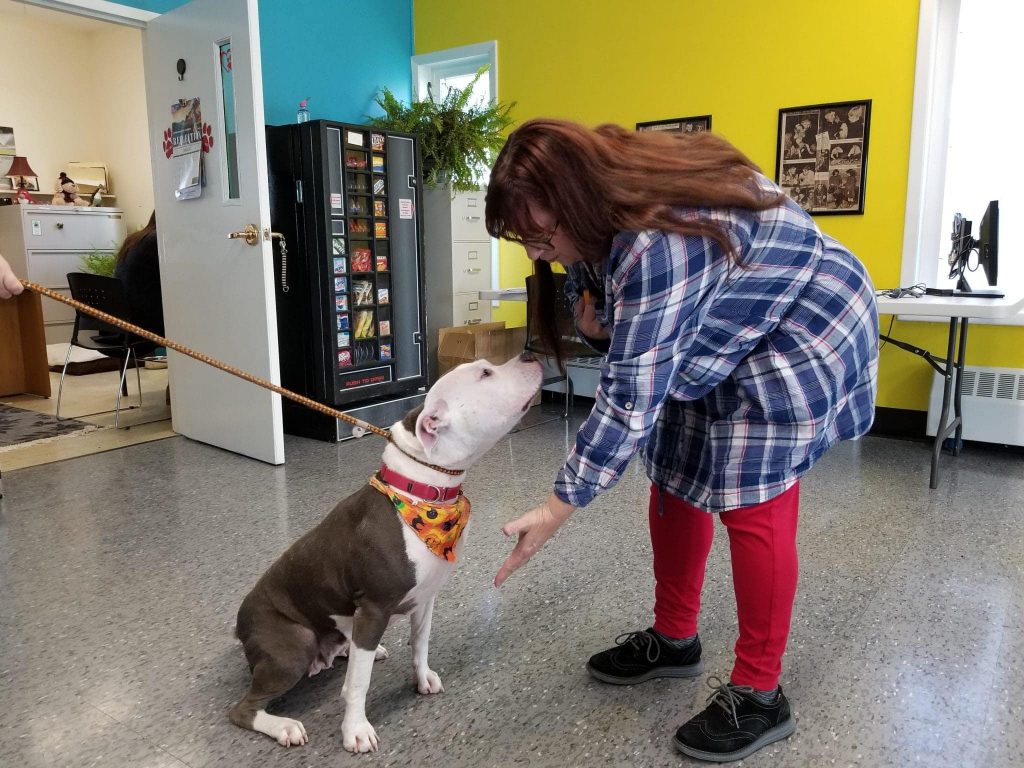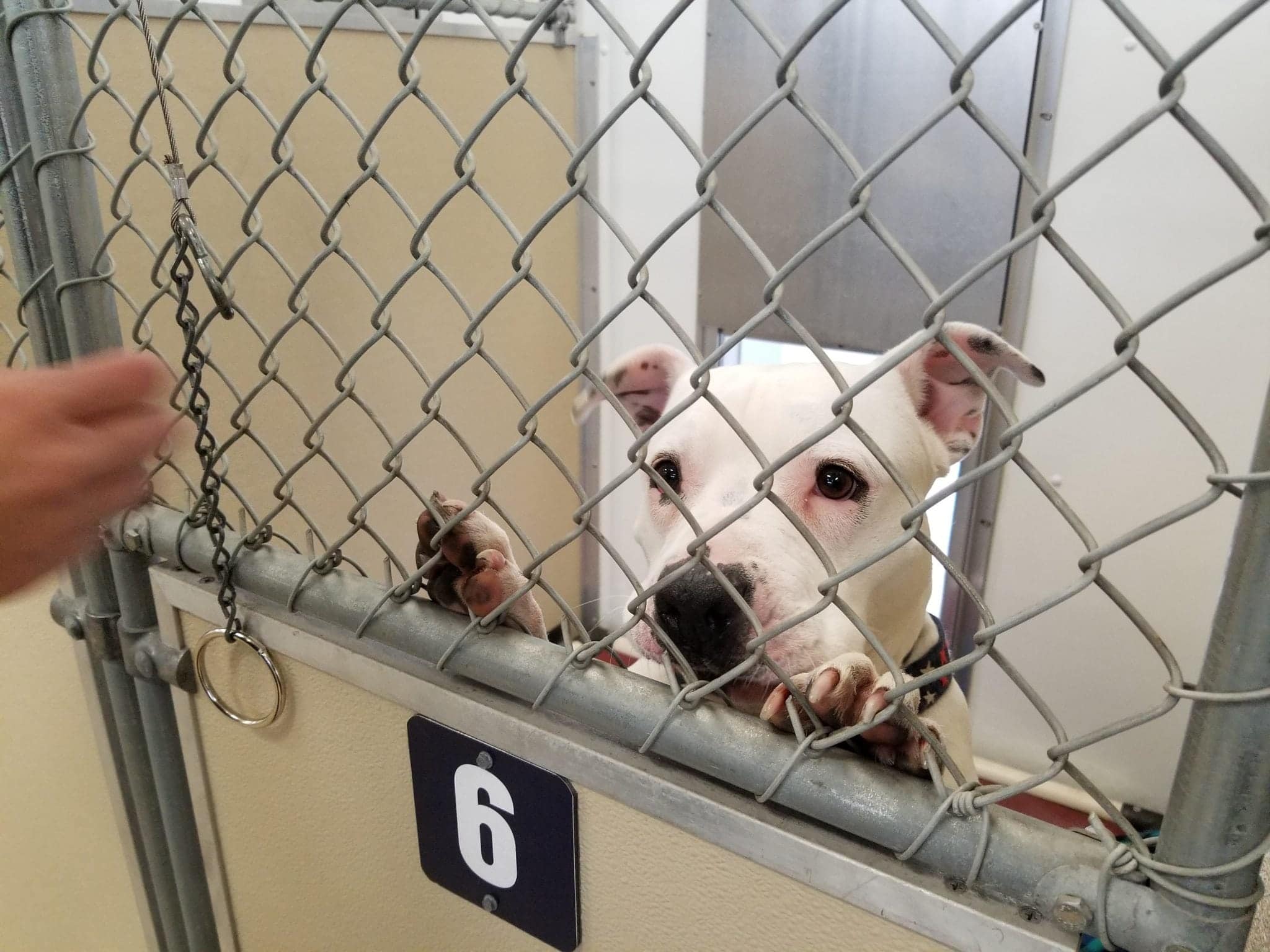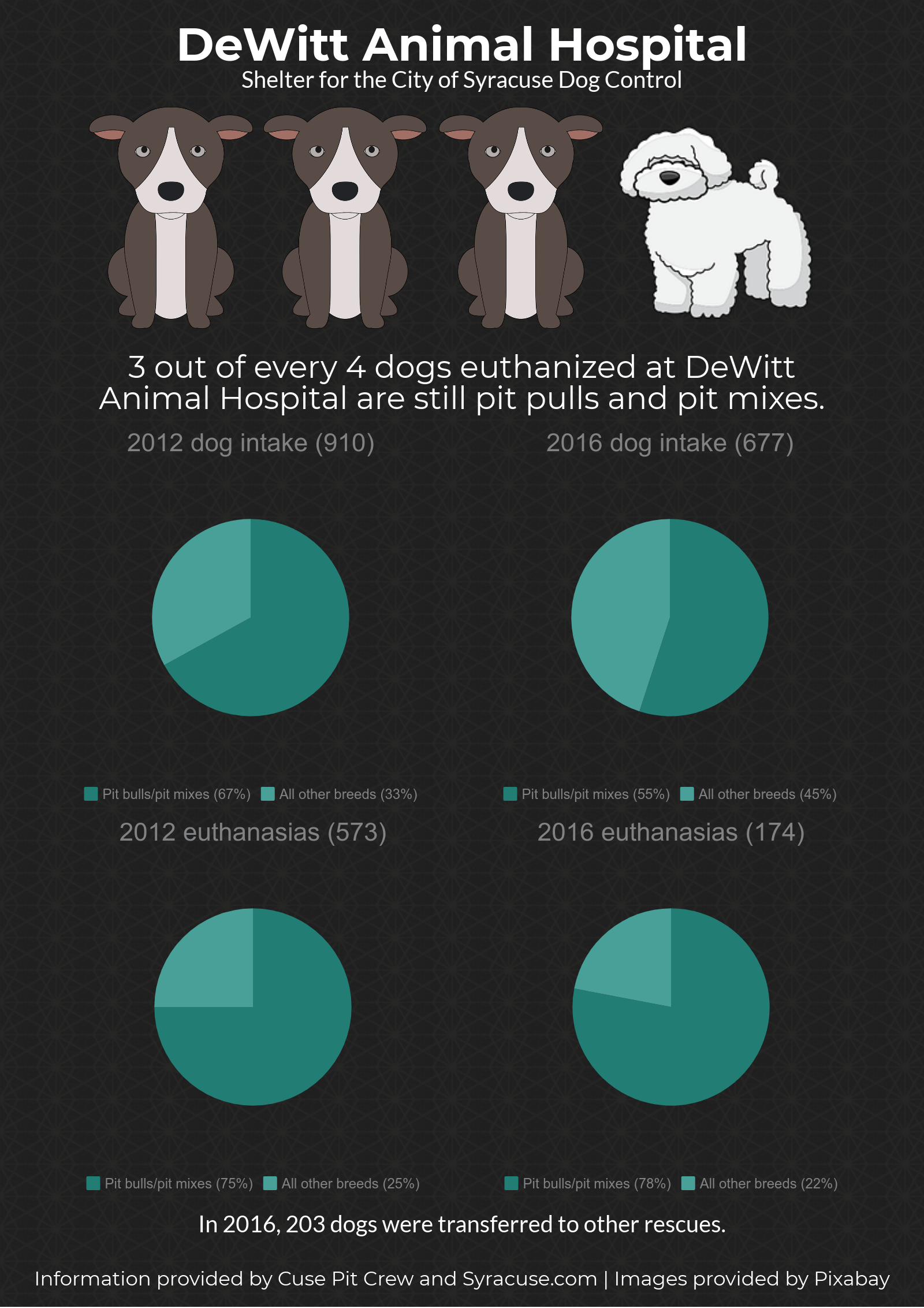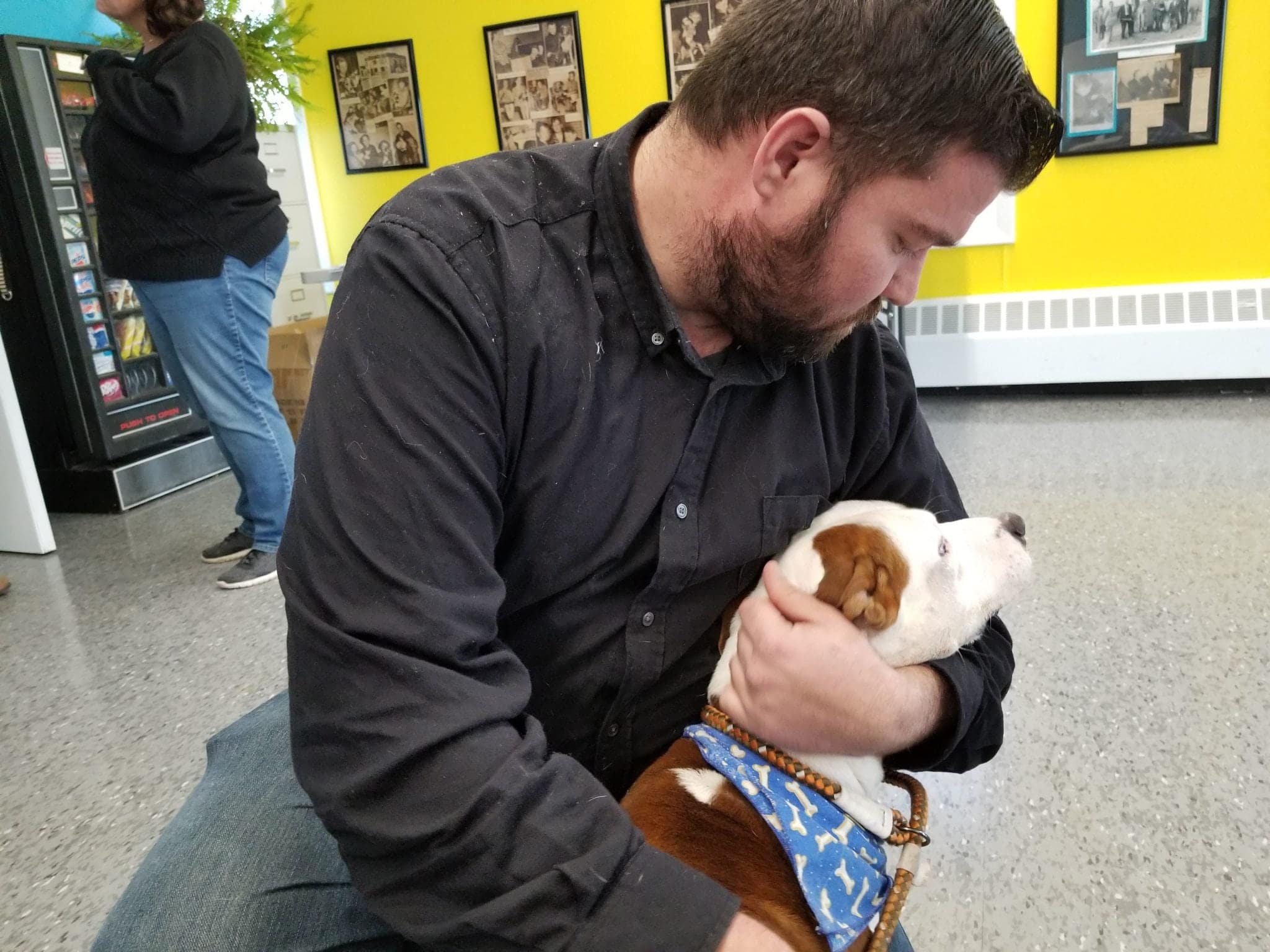After lowering canine euthanasia rates, Syracuse tackles pit bull population
Syracuse tackles pit bull population

The snow had not yet hit, but the sky was blanketed with gray clouds and the crisp December wind was unforgiving on the face. Despite the chill, Freya, a red-colored pit bull, relentlessly chased a red ball three times the size of her head in her play yard. While Freya was happy to be outside with her favorite toy, her tail wagging as she threw up gravel and dirt, the Onondaga County Department of Correction sat just on the other side of the chain-linked fence.
Welcome to Second Chance Canine Adoption Shelter in Jamesville, New York, just outside of Syracuse. Second Chance opened in 2015 with the goal of saving not only the city’s dogs, but also inmates, by having the two work together. Second Chance pulls dogs, mostly pit bulls, from the overcrowded DeWitt Animal Hospital, which receives the city’s strays from animal control.
“All the dogs we pull from there we’re pretty much pulling off death row and giving them a second chance,” said Kim Smith-Ford, the president of Second Chance’s board of directors.
The American Society for Prevention of Cruelty to Animals estimates there are 670,000 dogs euthanized in shelters across the United States each year. In 2016, 174 of those came from DeWitt Animal Hospital, with pit bulls and pit mixes making up 78 percent of those numbers. However, DeWitt’s most recent numbers provided by Stefanie Heath of Cuse Pit Crew are much lower than what they used to be. In 2012, DeWitt took in 910 dogs and euthanized 573, with 75 percent of the euthanized being pit bulls and pit mixes, according to Syracuse.com. The high percentage of euthanasia startled the city of Syracuse, and since then animal advocate groups have come together to solve the problem. While the euthanasia rates have decreased each year since – and are expected to be lower again when 2017 numbers are released – pit bulls remain the most commonly euthanized dogs.

Second Chance is a small shelter with only 20 kennels, but their ability to pull dogs from DeWitt Animal Hospital has helped decrease the city’s euthanasia rate. Since opening in October 2015, 140 dogs have been adopted. Second Chance not only aims to break down the aggressive stereotype against pit bulls, but also against inmates.
“They feed them, walk them, train them, take them in the play yard for enrichment, and they socialize these dogs all day long,” Smith-Ford said of the inmates. “It’s a huge perk to the program here because these dogs don’t sit in their kennels hardly at all.”
Also helping the dogs from DeWitt is Cuse Pit Crew, founded by sisters Stefanie and Nicole Heath in 2011. Cuse Pit Crew does not have a shelter of their own, but interacts with the DeWitt dogs at the shelter, takes them to educational events that expose pit bulls to the public and socializes them, and helps market the dogs for adoption.
“The numbers speak for themselves,” said Stefanie. “If we can say that adoptions are going up, euthanasia is going down, and those are the numbers we want to see, why wouldn’t we continue to help that and help them transition, and keep those numbers in those directions? It’s not ideal (to euthanize dogs). I’ll be the first to admit it, and I know DeWitt feels the same way.”
From the 910 dogs taken in at DeWitt in 2012, 146 were adopted and 142 were reclaimed. At first glance the numbers for 2016 don’t look much better. Of the 677 taken in, only 77 were adopted and 169 reclaimed, but this doesn’t account for the 203 dogs transferred to other rescues, a major step in lowering euthanasia rates.

Stefanie still serves as president on the Cuse Pit Crew board of directors while Nicole has moved on to facilitate the Central New York Animal Cruelty Task Force. The task force was founded in 2013 and is made up of multiple animal advocate groups around the city. The goal is to not only make the public aware of animal abuse and neglect, but also provide education and resources to prevent it. To make this possible, the task force has helped set up food pantries and low-cost spay and neuter clinics for financially strapped animal owners to take advantage of.
“If it comes down to losing their home, they have other resources other than leaving their animal behind or abandoning them,” said Nicole.
Stefanie also noted that the number of strays turned into DeWitt is decreasing.
“So what that tells me, we’re seeing our educational programs working, the spay neuter clinics working,” said Stefanie. “We’re starting to see this coming together after four or five years.”
In early November, the task force announced the start of their jail diversion program, where those arrested for animal abuse attend classes and group meetings for 16 weeks where they learn about responsible ownership instead of going to jail. The first session is a little over half-way through, with all 14 participants on probation.
“I would say people seem to be receptive, all things considered. We’ve received some good feedback so far,” said Nicole. She also noted they will have to wait and see if any participants will be repeat offenders.
Of the 75 inmates that have gone through Second Chance’s program, none have returned to jail. While these inmates are in jail for lesser crimes, such as driving under the influence, Smith-Ford gave as an example, working at Second Chance has made them come out of their shell just like the dogs.
“Some of them come in with that tough exterior, or not very social, and don’t want to open up,” she said. “These dogs just find a way to find their soft spot and by the end they’ve melted their hearts.
“We’ve had one inmate who was released and wants to come back to volunteer because he loved the program so much. We have another inmate who fell in love with one of the dogs here that he worked with and ended up adopting that dog.”
The inmates usually spend three months working with the Second Chance dogs. Learning how to care for them and train them provides a way to build skills they can use once out of jail and serves as a way to de-stress from the jail environment.
“These inmates light up with these dogs. They love working with them,” Smith-Ford added. “I’ve caught inmates before in the kennels laying on the beds with the dogs. I’ve heard inmates baby talking to the dogs. And it’s just so great to see.”
While Second Chance is a small operation run by volunteers, the Central New York Society for Prevention of Cruelty to Animalsaverages 60-65 dogs in house on any given day. C.J. Kulesa, the events and special services coordinator, estimates 90-95 percent of them are pit bulls or pit mixes. Most of the dogs that come into DeWitt are strays, but CNY SPCA also receives many from abuse and neglect, abandonment and owner-surrenders, which is when an owner drops a dog at a shelter because they can no longer care for the dog, no longer want the dog or are moving somewhere they are not allowed to have the dog.

Pairing dogs with the right owners can be difficult. Families may pick a dog off their looks, but having cats, other dogs, children or a busy lifestyle can make a poor match when taking a dog’s personality and past into consideration. The Monday before Thanksgiving, humane educator Dee Schaefer said the CNY SPCA started a new initiative hoping to increase adoptions and prevent dog returns.
“So what we’re doing it’s called the Woof Connection. And if you come in, I’m going to be interviewing people. What’s their environment? Are they a busy family? Do they own another pet? Do they plan on getting another pet?” explained Schaefer. “Based on that, we’re going to make the match for them from some of these dogs. If they adopt the dogs we suggest, because we know these dogs really well, it’s going to be a free adoption. If they choose to go with another dog that’s not going to be such a good match for them, they’re going to have to pay.”
Dumbo, an 80 to 85 pound pit bull, was a stray and gave birth while at the CNY SPCA. While she loves people, she has a high prey drive. She was adopted, but brought back about a week later because she killed a cat. While in one of the socialization rooms at the CNY SPCA, her main focus was not on the people, but on a parrot in his cage covered by a sheet.
Opposite of Dumbo was Popeye, about a year old, smaller and timid, who tried to turn back to his kennel. Popeye had come from a hoarding case with 18 or 19 animals and was tied outside. He reluctantly walked into the socialization room with Kulesa, his tail tucked in between his legs. While a small group of people tried to take pictures of him, he pressed against Kulesa for security.
Kulesa’s own pit bull, Bella, also came from the CNY SPCA. She was bred to sell puppies and had no socialization until neighbors reported her poor condition after spotting her on a bathroom trip outside.
“She was severely neglected, she was a year and a half old, and was on her second litter when her cruelty officers busted her,” said Kulesa. “Her puppies were chunky little things because they are typically exceptional parents, but she was emaciated. You could count every rib on her body. She was locked in a basement. The only exposure she had to humans was the children that would go down and see her. But she came out of it, she’s a great dog.”
Despite little interaction with other animals, Bella gets along with Kulesa’s other three pit bulls, but others are best being the single dog in a home.
The problem with adopting out pit bulls is their aggressive stereotype. The stereotype is enforced with pit bulls being the choice among dog fighters because of their strength and muscularity.
“The pit bull type dog is loyal, so eager to please its owner, it will do anything,” Smith-Ford said. She explained that pit bulls are not naturally aggressive, but will act that way if trained because they want to make their owner happy.
“The dog doesn’t know, because the dog’s getting treats and praise from the owner,” Smith-Ford added.
Amber Gray owns a rescued pit bull-boxer mix, Kassie, who is about 4 years old. Gray describes Kassie as playful but less excitable than she was in her puppy days. She has never seen Kassie show aggression and calls her a people dog. Despite Kassie’s personality, Gray has experienced people judging her dog before meeting her.
“I remember one time I was coming down the street and this family was coming out of their house to go to their car. Kassie’s got a lot of energy, and if you’re not ready for her she can be startling,” said Gray. “I stopped two houses up. I stopped and held the dog waiting for them to get to their car. They didn’t even see me until they were just about at the car, and the mother did, and she jumped back and said, ‘That’s the type of dog Daddy was talking about,’ and they hurried and got in their car. And I was like, ‘You’re not a bad dog.’”
Gray also remembers having Kassie outside the house while training her and a neighbor across the street, who had never met the dog, yelled, “There’s a vicious pit bull loose across the street. Don’t go over there.” Gray simply stepped in her neighbor’s line of site, waived, and went back to training her dog.
One thing that changed in Kassie, Gray noticed, is that she is more protective of the house now, a change that happened around the time Gray became pregnant with her daughter.
“I have an 11-month old, and they’re best buds. If I was ever afraid of my dog hurting my baby, I wouldn’t have that dog.”
Collin Buck has not personally experienced negativity from people toward his pit bull, but has faced issues with other dogs. Buck has taken his 4-year-old pit, Lily Munster, to Wegman’s Good Dog Park in Liverpool on multiple occasions where she plays fine with others. Although Lily is not aggressive toward other dogs, she was on the receiving end of a dog attack when a collie came after her.
“She’s just not aggressive,” Buck said. “She doesn’t go out seeking to be angry. If we’re out and we see a person, she wants to say hi, she’s very friendly.”
Back at Second Chance, Smith-Ford stepped back inside the kennel area after Freya ran the ball over her feet and then back to other side of the play yard. She walked down the row of kennels, giving treats as dogs placed their paws up on their doors.
Here, the dog’s breed isn’t listed on his or her kennel door, just their name and a report card that shows their behavior.
“A dog’s breed should not matter,” said Smith-Ford. “They’re all just dogs, and they are all just individuals.”





